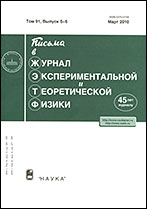|
This article is cited in 8 scientific papers (total in 8 papers)
OPTICS AND NUCLEAR PHYSICS
On laser-induced high-order wave mixing and harmonic generation in a graphene quantum dot
B. R. Avchyan, A. G. Ghazaryan, K. A. Sargsyan, Kh. V. Sedrakian
Centre of Strong Fields Physics, Yerevan State University, Yerevan, 0025 Armenia
Abstract:
We present results of numerical investigations of high-order wave mixing/harmonic generation (HWM/HHG) with many-body interaction processes derived by a strong two-frequency circular laser field in a graphene quantum dot (GQD). The influence of the relative phase of such a laser field on the spectrum of high-order harmonics generated in the GQD is shown. This may allow controlling the polarization of the generated harmonics. The GQD is described by the nearest neighbor tight-binding (TB) model. The multiparticle interaction is considered in an extended Hubbard approximation. We solve quantum kinetic equations in on-site representations for charged carriers by method have already applied by us, and obtain a general formula for high-order wave mixing/harmonic generation processes in GQD. The considerable enhancement of the HWM/HHG yield due to the matching of the symmetries of the light-wave–dot system takes place for the GQD with the particular group symmetry. The analysis of obtained results confirms enough efficiency of HWM/HHG in GQDs of the triangular and hexagonal shapes with zigzag edges at certain phases of a two-frequency circular laser field.
Received: 15.08.2022
Revised: 23.08.2022
Accepted: 26.08.2022
Citation:
B. R. Avchyan, A. G. Ghazaryan, K. A. Sargsyan, Kh. V. Sedrakian, “On laser-induced high-order wave mixing and harmonic generation in a graphene quantum dot”, Pis'ma v Zh. Èksper. Teoret. Fiz., 116:7 (2022), 426–433; JETP Letters, 116:7 (2022), 428–435
Linking options:
https://www.mathnet.ru/eng/jetpl6767 https://www.mathnet.ru/eng/jetpl/v116/i7/p426
|


| Statistics & downloads: |
| Abstract page: | 39 | | References: | 9 | | First page: | 4 |
|





 Contact us:
Contact us: Terms of Use
Terms of Use
 Registration to the website
Registration to the website Logotypes
Logotypes








 Citation in format
Citation in format 
